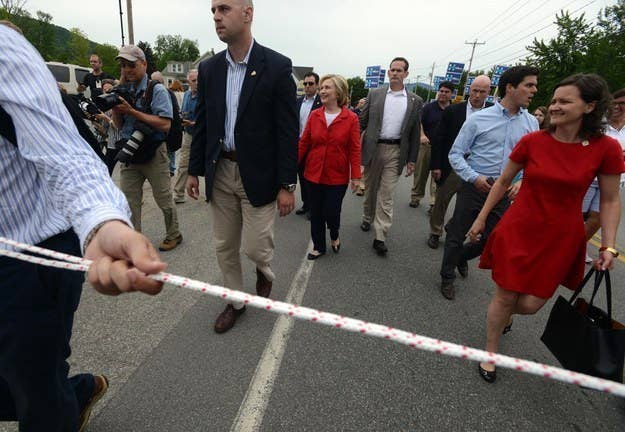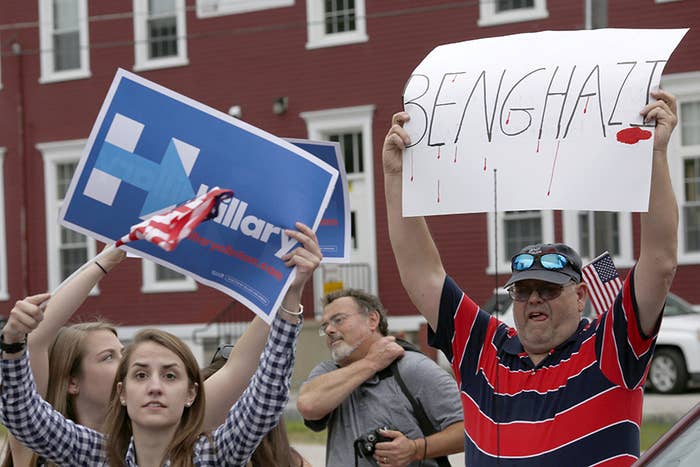
GORHAM, N.H. — Hillary Clinton looked perfectly at ease on the morning of Independence Day. She stood on the back-deck of a supporter’s house, a wrap-around porch looking southeast over the White Mountains of New Hampshire, and she talked. She talked and talked and talked — almost for an hour.
This was not exactly typical — but Clinton was comfortable. She threw her head back, laughed at jokes. She lingered afterward to speak with guests. She talked about her mother, her granddaughter; about the economy, energy, education; China and Iran and Vladimir Putin; the Affordable Care Act, same-sex marriage, substance abuse, student debt. She talked about her dogs, Maisy and Tally.
At one point during the event on Saturday morning — an organizing meeting in the town of Bartlett, N.H. — Clinton referred to the crowd as “people like us.”
Campaign officials, now three months into the race, have prioritized settings like this one. They are small, “intimate” places where Clinton can “connect” with the “Everyday Americans” to whom her aides refer frequently in press releases.
The events, aides have said, are tailored to the candidate’s strengths, and crafted with the understanding that Clinton — as one of the most scrutinized figures in politics, followed wherever she goes by the press and a band of Secret Service agents — faces the particular challenge in this campaign of making herself accessible, to the “Everydays,” as an “Everyday American” herself.
After the organizing event in Bartlett, Clinton ventured outside the bubble her campaign has created in this endeavor — about 30 minutes northeast, near the top of the White Mountain region, to a Fourth of July parade in Gorham, N.H.
As soon as she started down Route 2 — the main drag of this small town in the state’s North Country — Clinton was still smiling, but something had shifted.
This was not the back-porch in Glen, garden and lily-pad pond below. As she moved in front of a large contingent of supporters, many holding signs with the “H” logo of her campaign, Clinton was trailed by about three loud and persistent protesters for the entirety of the parade. They followed even as Clinton's pace quickened, greeting residents along the way on both sides of Route 2.
The most vocal heckler, Carl Gagnon, 59, from nearby Berlin, carried a poster that read “Benghazi” in black ink, with red droplets hanging like blood from each letter. He walked along the right shoulder of the road, always parallel to Clinton, hoisting the sign in the air as he maneuvered past voters hoping for a handshake.
“Where were you at 3 o’clock in the morning when the phone rang!” Gagnon yelled.
“Tell us about when you were POOR!”
The fans behind Clinton chanted back. “Hill-a-ry! Hill-a-ry!”
“HILLARY, where were you at 3 a.m. when the phone rang on Sept. 11?”
His unflagging pursuit marked a first in this campaign: Never before has Clinton had to confront, in such close proximity, a hostile challenger — or a force that so disrupts one of the closed, controlled events she's hosted in the key primary states.

And unlike the large share of her appearances this year, the parade in Gorham was open. Anyone could go. Reporters were free to walk in the street next to Clinton — until about halfway down the route, when two campaign aides brought out a thick white rope, which they held like a clothesline in front of the candidate.
Members of the press were forced to stay on the other side. Clinton moved quickly, and to keep up, reporters trotted backwards, rope at their waists. The idea, aides said later, was to create a buffer — space where the candidate could interact.
Clinton did not engage with the protesters — or with the reporters who asked her about the scene that quickly overtook the Fourth festivities. (As one passerby put it, “Maybe if the cameras left, we could get on with the parade.”)
Clinton did not, in fact, acknowledge that much was happening at all.
One reporter, pacing in reverse, asked, “You having fun?”
“I’m having a great time,” Clinton replied, with Gagnon still nearby. (As if to prove the point, she stayed on his side of the street until the end of the parade.)
“You’re a carpetbagger,” Gagnon yelled. “YOU’RE A CARPETBAGGER.”
Clinton looked ahead — walking fast, holding her smile.
The din grew louder, and Gagnon kept shouting. Another protester, a man on a motorcycle, cried out, “What about Benghazi, Hillary? What about the emails? You’re a LIAR. That’s all that matters.” The horde of supporters — following with their “H” signs — tried to drown out the dissenters. “Hill-a-ry! Hill-a-ry! Hill-a-ry!”
“I can’t tell if that’s booing or cheering,” one Clinton aide said.
The effect was jarring, at times chaotic.
As the whole party sped along Route 2, a small boy tripped trying to cross the street. He fell to the ground and was almost trampled by a Clinton aide monitoring the rope. The staffer looked down. "Are you okay?" The boy flashed a sad, angry look. "He looked okay," the staffer said, still walking backward with the parade.
“All right, guys!” the aide told reporters. “Pick up the pace a little with the rope.”
When she reached the end of the procession, Clinton posed for a photo with the supporters who’d marched alongside her campaign — then looked ready to leave.
Gagnon was across the street, comparing notes with other protesters. “Congrats, guys,” one said. “We got a sound-byte out there.”
Heading for the motorcade, Clinton took a question about the parade.
“It was fabulous!” she said, still smiling.
“You know, I love parades. I love walking in parades. We got such a great response — a lot of enthusiasm and energy to celebrate the Fourth of July.”
She waved and, after 20 minutes in Gorham, she was gone.
“Thank you, guys!”
Fifteen minutes later, Clinton was at her last stop of the day — an unannounced trip to Northland Restaurant in Berlin. The place was mostly empty. But by the the time reporters arrived, Clinton had already shifted into a more natural mode of campaigning — moving table to table, topic to topic.
She talked about Internet access with one couple. (“…And that’s why we need to do for broadband what we did for electricity.”)
Workforce development with another. (“…I think we made a big mistake when we began to phase out vocational and technical education in high school.”)
And on she went.
“Hi, I’m Hillary Clinton. How are ya?”
